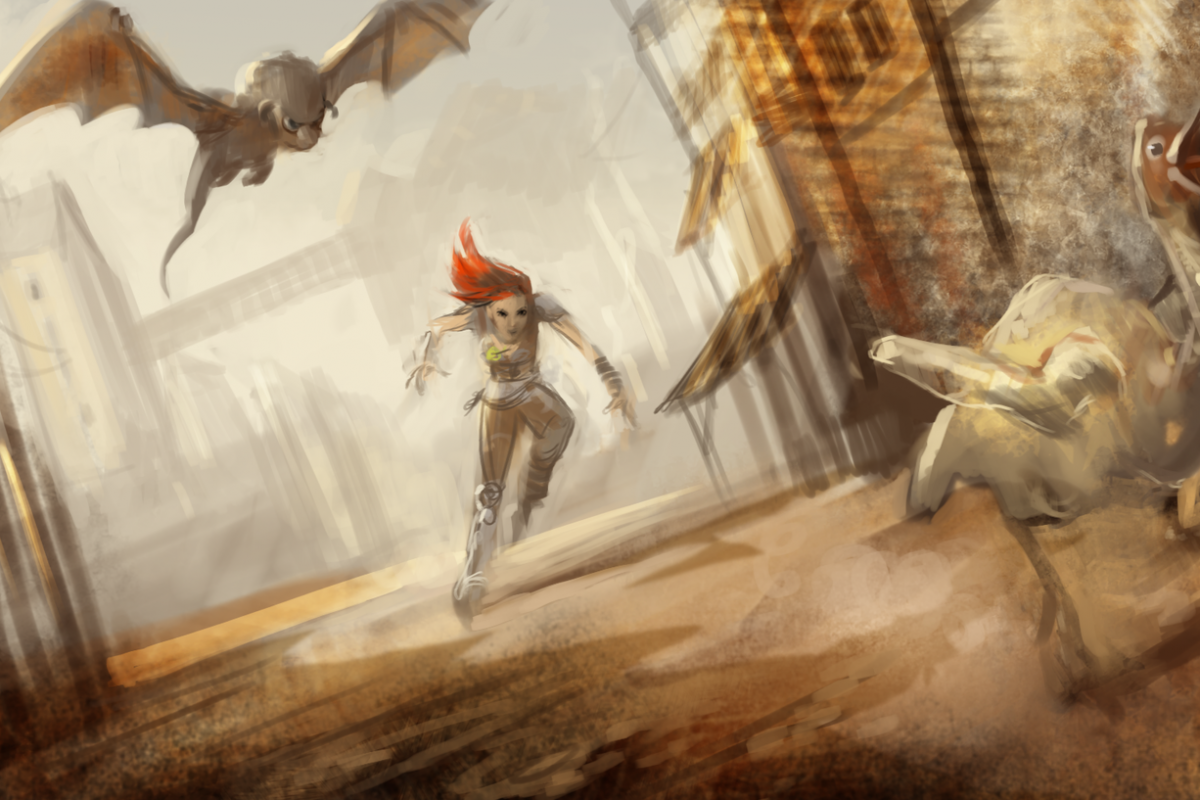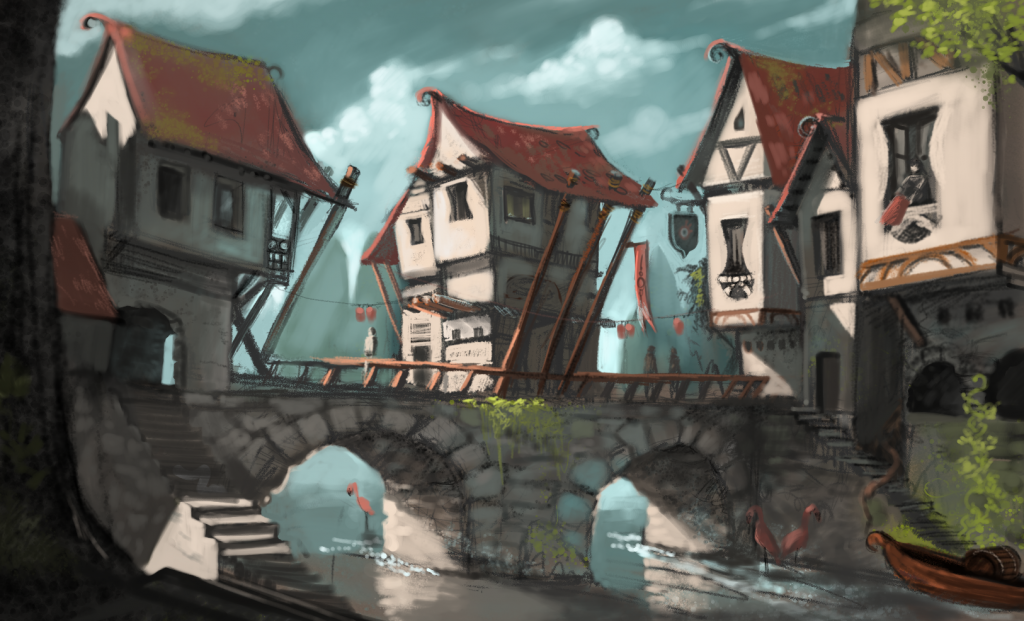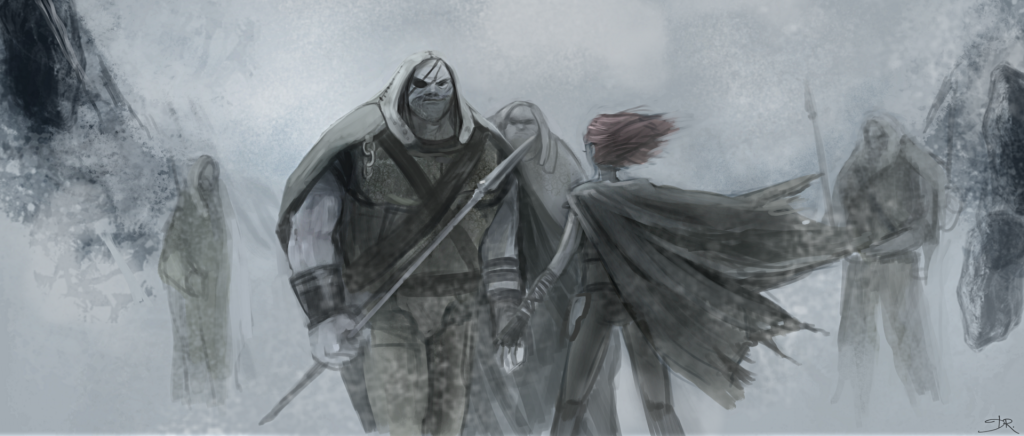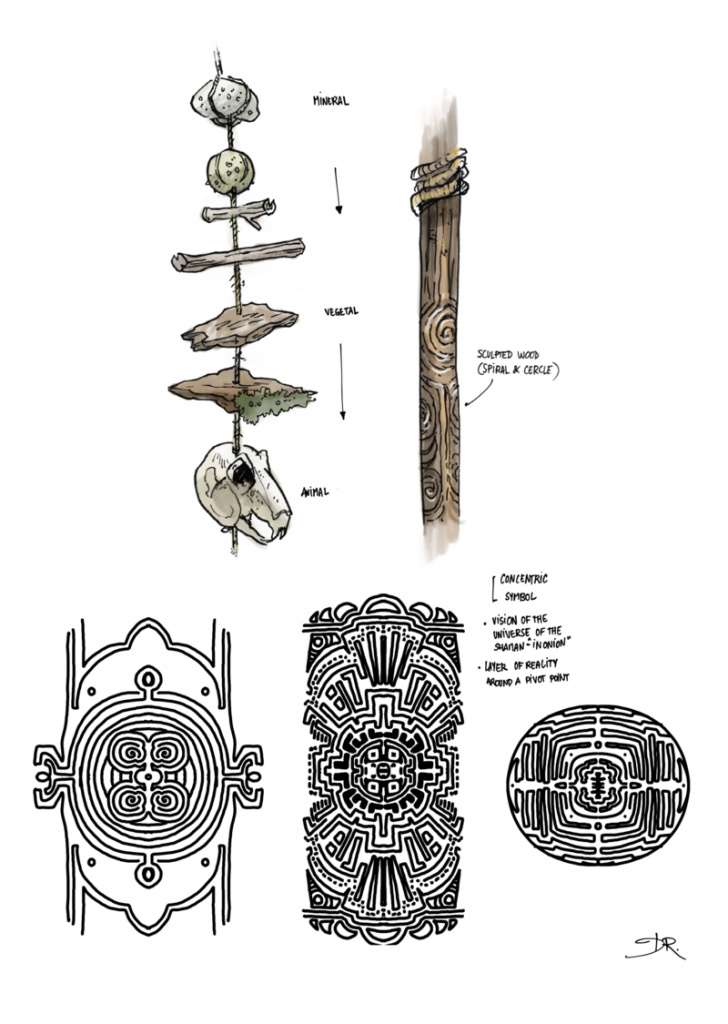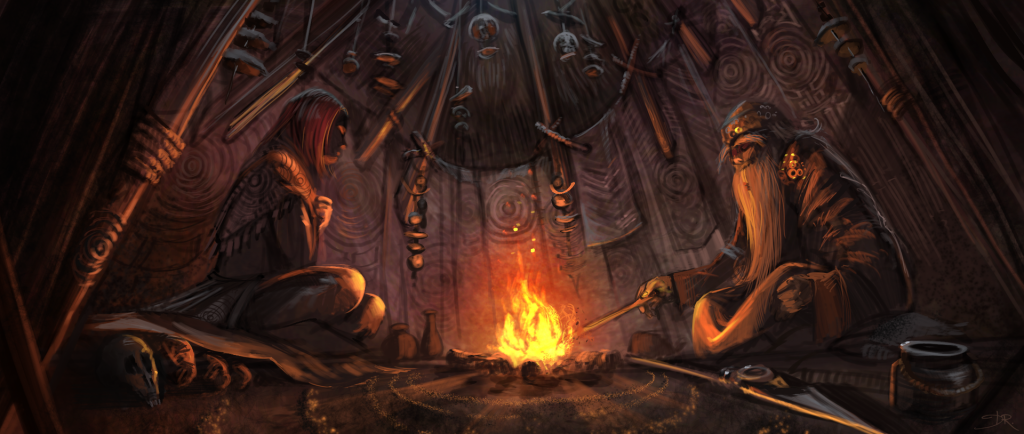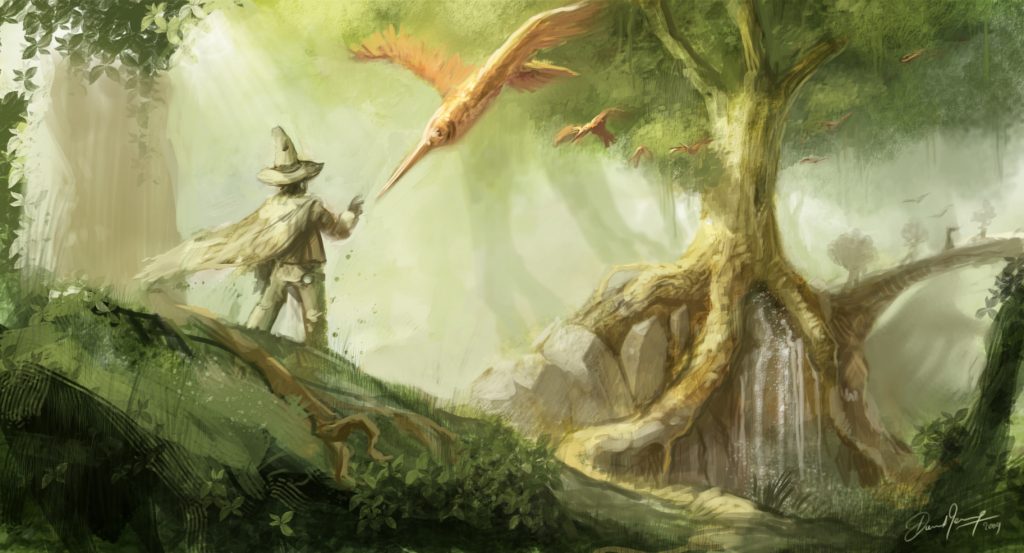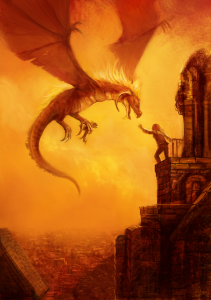Are you familiar with the tales of heroes plucked from the mundane world and hurled into fantasy to fulfil some prophecy or for no discernable reason at all? This is that – made into an crunchy, modular RPG.
All art is Creative Commons not affiliated with Conjured Outcast: By David Revoy / Blender Foundation - Own work, CC BY 3.0, https://commons.wikimedia.org/w/index.php?curid=22488156
Paid Review!
Firstly, this is a paid review! The first on this website, actually. The design team behind Conjured Outcast reached out to pay for my time to read, make notes, consult, and review their Tabletop Game before it moves into the final phases of production for release.
If making money irks you or grosses you out, just remember: I gotta pay rent, same as anyone. Paid reviews are a net positive for me and for you. You should know by now I’ll not mince words or lie. I have a responsibility to myself and DropTheDie as a brand to uphold my own standards. That’s way more important to me than sane amounts of money.
Content Warnings: Racism, Sex, Cultural Appropriation (Judaism)
As you know, the Tabletop sphere is steeped in 40 years of bigotry, xenophobia, racism, sexism, and appropriation. Only recently have we, as a community, come together enough to educate and hold people accountable for what they produce. In the spirit of transparency, when I came across such leanings (intentional or otherwise) in this book, I addressed it with the creators after informing them that the conversation was to be transcribed in enough detail for anyone who happens upon my website. The following three things stood out to me as potentially problematic if we hope to shake free of those trappings in the coming future of Tabletop Gaming.
Racism: “…isekai? I don’t speak rice ball!”
In Japanese stories (traditionally manga) an “isekai” tale is one that involves a main character being transported to another world through technology or magic. A fitting descriptor for Conjured Outcast! However, the term “rice ball” that follows is a condescending racial slang term used typically to insult those of East Asian descent. Though its use has dropped considerably since WW2, even if it were not a known slang term, the racism of the statement remains apparent.
When I reached out to Kitsune Comforts, who paid for the review, they replied “I guess that’s racist? But I’ve never heard once heard of a person of Asian decent referred to as a rice ball,” and explained the phrasing on the basis that the narrator (who spoke the line) had been imprisoned in a space outside of time and reality.
When I did confirm the term had serious racist undertones, Kitusne Comforts did see how that language was problematic and harmful to potential readers and made assurances that not only would it be removed from the game, but that a new version could be sent to me with that, and any other phrases believed to be problematic, removed.
Sex: The Lust System [Optional]
Included in the game are mentions of an optional “lust” system and the associated skills: seduction, deep breathing, healing hug, pain as pleasure, and secret ingredient. It was my suggestion these (and potentially other) adult and sexually themed options be pulled from the core book and offered in a free or potentially purchasable release alongside the main game. Those suggestions were taken under advisement. On the whole, they’re not overtly disturbing or troublesome, but a supplementary product with them in it would be a much safer reading experience and those spaces could be explored more fully for the many gamers who love romance and sexuality in their tabletop experiences.
Cultural Appropriation: “Golomancy”: The Magic of Golems
It is
widely known in Dungeons and Dragons circles that the cultural
appropriation and use of the term “Golem” from Judaism, is seen
as anti-Semetic by Jewish gamers. I also reached out to Kitsune
Comforts about that issue, having recently seen the backlash first
hand on a 5e product release, and informed them of the Jewish stance
on the matter, advising they bring on a sensitivity reader,
particularly a Jewish consultant, to advise on its inclusion, as
“constructs” is a viable and fitting term.
The reply, in
plain text, is as follows:
“…saying golomancers need to be taken out because it’s Jewish is the same as saying the monk needs to be removed because it’s Greek, or the assassin because it’s Persian, or the wild magic mage because it’s Irish, or paladin because it’s French. Words and names mean different things now than they did ages ago and English borrows so many words from other cultures it’s inevitable that we’ll end up using non proto germanic words to describe concepts in an easy to grasp way. . . If people want to be upset that they get to play a class that does something special from their culture or another one then I can’t really do a whole lot about that. If we change the name people still know what golomancy is and will quickly call us out for “stealing a cultural idea and trying to hide it.” We aren’t going to hide from the influences in our game and we genuinely want to include cultures from around the world and if people have a problem with being positively represented in a fantasy game, about a fantasy world, with fantasy war, and fantasy guns, and fantasy magic, then those people aren’t our target audience.”
The Game In A Nutshell
This game may be difficult to understand the premise of – due, in part, to the tongue-in-cheek humor that’s used to keep the pages humorous and lighthearted amid overwhelming amounts of information and mechanical crunch.
It was on my second reading of the first 6 pages that it clicked – what the game’s core premise is: Players are brought, in their entirety, to a fantasy world as character avatars. Much in the same vein of John Carter, they are fantastical in this new fantasy space despite being mundane here on Earth, as determined by the mundane objects in their life, as described in character creation.
What ‘conjures’ you into the fantasy realm, what holds you there, and what your objective is – is unknown and left amorphous as to be tailored to the group and Game Master. It’s an open-ended system with very little guidance as to the story, goals, and aspirations of the characters but minces no words about that fact. From the first few lines to the last pages of the per-release rule set, it makes a firm point that the success and enjoyment of the game is predicated on how the players interact with the world and how creative the group can be with the system.
Some settings that come to my mind when reading it are: The Princess of Mars (John Carter), The Sword of Rhiannon, The Dark World, Escaflowne, Tomorrowland, Tron, or a host of videogame stories told from the perspective of a trapped player such as Sword Art Online. The number of reference material to draw from is neigh limitless, as the idea of losing oneself in a fantastical world is as old as time.
Crunch
XP, LP, HP, CDE, DE, AT, MP, ML – there’s a lot of abbreviations floating around in these pages that I hope get fine-tuned for a future full release, but most of them have trappings you’ll find in familiar TTRPGS: Experience, Life Points, Hit Points, Combat Defense, Defense bonus, etc. But not only are you playing yourself — there is no traditional leveling system.
One of the things I hear people discuss a LOT is how much they prefer Pathfinder’s mechanical crunch to other fantasy TTRPGs like Savage Worlds, Dungeons and Dragons, or Dungeon World. If that kind of max/maxing and numerical bookkeeping is for you, I think this system will probably scratch that itch.
For instance, Hit Points act as stamina (could probably be renamed stamina) effectively giving you a barrier before you start to lose vitality, blood, health. Your Life Points (LP) come in a 1:10 ratio with your Hit Points and they reflect how tough and hard to actually damage/kill your character is. It gives a new mechanical representation beyond “HP” found in a lot of tabletop games. Where D&D says Hit Points are some kind of catch-all for your luck, vitality, vigor, etc, Conjured Outcast doesn’t want to give a catch-all solution, it wants to quantify and qualify EXACTLY how your mechanical health operates.
Likewise the system has a slew of training and leveling options that means each character has dozens of opportunities to add 1 point to various checks, defenses, or rolls. It’s not a tight system by any means, but I think for people who enjoy optimizing certain builds, spells, abilities, and situations to eek out the best numerical advantage possible – this kind of crunch will be pretty satisfying.
Character Generation
Characters are actually a stylized reflection of the player themselves. PCs are to pick two features of their own bedroom (in real life) to influence who they are as a character. Mundane aspects and objects of the bedroom give statistical changes [a bedside table = -50 encumbrance, Running shoes = +1 to CDE]. It’s a weird, quirky way to generate a character for a system with no level progression, but a lot of the allure of the system is in that quirky nature and presentation of the game.
If it fell back into “tried and true” game cycle: choose a race, choose a class, choose a background, blah blah – it’d lose the primary draw of the game, in my opinion. This single idea is the most unique and dynamic of any in the system and I’d love to see this section broadened to be a full chapter with examples of previous player characters and how their generation came to be.
Classes
Each of the classes rely heavily on crunch (such as +5 AT when undetected, +20 on recruit rolls, etc) more-so than flavor, unique descriptions, or lore.
What flavor there is comes in the form of quips that give a cultural touchstone to the class. One example I liked is Beast Lord: “Go, Dragon! Use fire breath! [it was super effective!]” I think this is a surprisingly cool way to handle classes in the first place. The pop culture references match with our real-world experiences to give everyone an understandable flavor to their fictional selves without needing long explanations and exposition dumps. “Why can I control beasts in this realm?” – because you watched Crocodile Dundee as a kid and /really/ wanted to do it. It’s weirdly elegant for this particular system.
Combat
Combat is, in opposition of the mechanical nature of the classes, fairly amorphous. There is no system for turn order – only that if no one takes a turn in “ten seconds” then the enemies take their turn. It offers a more frantic and party-game quality to the initiation of combat, I’d imagine, but not necessarily a bad thing. As a DM, I’d probably forgo this rule and use literally any other option to establish order, as I know some players would just start screaming before combat even begins “I RUN, I HIDE! I HIDE! I’M HIDING! BEFORE THEY GO, I’M HIDING!” and I don’t want to hate anyone that much.
The flow of a combat round (6 seconds, same as D&D) goes as follows:
- Someone speaks up and goes first.
- Movement is made
- Attacks are made. Each attack has to be defined as slow/medium/fast and uses a different kind of die. Critical Hits are determined.
- Flanking, ambush bonuses, helping bonuses, and all other factors are considered.
- The target of the attack makes a defense roll, that’s decided by rolling a d8 plus the character’s defense bonus which reduces an attack’s damage.
- Damage is tallied and subtracted from HP or LP.
Each attack that you make needs a LOT of thought put behind it, which means attack-heavy combat rounds will be pretty goddamn slow, if my own history is any indicator. There’s a chart and formulas for determining the speed, weight, power, and ABRASIVE damage for charging, for example.
Now what I see, in terms of design philosophy, is that the game is made to make combat matter a great deal. There are fewer opportunities for a player and their character to say “I swing, 18, 9 damage.” as you get in most standard fantasy tabletop games.
A lot of the crunch for the combat turn cycle will take place outside of the combat encounter: factoring bonuses, recording totals, adjudicating character status effects (there are MANY), and preparing proficiency and XP-fueled attacks. What I’m saying, in summary, is that the player needs to know and have already recorded their bonuses and how they are applied BEFORE their turn comes around, or a single round of combat could take an exceptionally long time. Again – it’s a crunchy numbers system. Players who don’t track their numbers will struggle in every aspect of this game, so be sure they’re ready to dive in.
Equipment and Proficiencies
This system is going to really push the bookkeeping aspect of Tabletop RPGs to the breaking point. Every weapon, from a stick you found to a perfectly crafted dwarven axe has to be maintained (a “fresh” quality) that affects if it can or cannot crit or perform specific XP actions. Each weapon also gets various attack speeds and types – there will be a lot of fine tuning to get the most out of equipment for each character and class combination. Once the “fresh” quality is gone – it’s gone until you tend to the weapon again: oil it, sharpen it, bind it with leather, you get the point.
Proficiency
As far as weapons are concerned, anyone can wield a weapon but actually using it WELL requires a whole lot of time and energy. Only after 100 encounters does a character use it without subtracting from their attack rolls. After 300 fights, characters become so skilled they practically never miss and can use up to 3 of the highly specific XP Actions. You’re more likely to want to roleplay training and building up skill, and tackling small, easy to manage fights than you are jumping feet-first into every combat that comes along.
Armor
One thing I do like about the armor system is a sense of rock/paper/scissors to what armor someone wears to each encounter. A cloth Gambeson, by example, gives extra protection against blunt damage, but suffers from slashing. Having 20 or so types of armor (from leather cuirasses to harden steel full plate) means a lot of them end up filling a niche in terms of usability. The system suffers, I think, from trying to codify piecemeal armor. It’s been done in systems such as Pathfinder, but largely people do not find them helpful or all that usable, as having a full set made is often easier than slapping on random bits and factoring your armor total. Luckily, it doesn’t take up too much space and isn’t all that intrusive, so most people can easily ignore it if it is not right for them, but those who want to wear plate boots and gloves with a leather breastplate and boxer-briefs can live their dream.
Skills and Other Bits
So skill checks (d100 – d100 in opposition for the environment) and crafting, along with their tools, take up a HUGE portion of the reference doc but left me relatively unimpressed.
There’s
a pitfall to consider when you’re giving people huge swaths of
“crunch” information – stats and what not. If you just give
them page after page after page of numbers and abbreviations, it
turns into white noise, completely fruitless for players.
HOWEVER
– if you flood your mechanical crunch with extraneous stuff, it
feels even more padded and pointless. For instance, when the
“cooking” skill is brought up, there’s 161 words to say “Cooking
is learning to bake, grill, and prepare delicious symphonies with
various ingredients.”
I feel that such a simple thing as a “skill vocabulary” or “crafting dictionary” could be SO much more useable. A single line explaining what the skill is, and 3 sample checks. “-Algara found plentiful mushrooms on the road and used cooking to make a lovely stew with them, rolling a 55 vs 37.” or something.
The same is true of the crafting tools. “Trusty Axe” could say “A razor-sharp wedge perfect for cutting, chopping, and hammering thanks to its heavy construction.” But instead the book reads:
“Although it’s no hammer, it is hammer like and because of this fact you can use it to also violently beat things apart. But not furniture, mostly trees, unless you really want to fuck everything up, again…. BUT! In the event that you want to live out your fantasies of being a lumberjack, much like Jackal’s lead singer, you certainly can if you have this wonderful tool at your command!”
I completely understand the intention is to give the reader a bit of humor and lightheartedness to latch on to, something to give a chuckle or scoff of confusion as told by the narrator. But self-evident and mundane, non-complex things should be left as unobtrusive as possible. Much like punctuation, readers will just breeze past things they don’t really care about. Those few thousand words saved could go to FAR better places: short stories of characters past, examples of the how the mechanics function, all sorts of other things.
Magic
Before I even begin, the magic system is where many reviewers have planted their flag – so I’m intrigued to see what it’s all about.
Magic schools
You’ll find common terms here, other than some name changes:
Abjuration == “Negation,”
Illusion == “Compulsion,”
Necromancy == “Instauration.”
They’re all what you’ve come to expect from common fantasy trappings which is not a bad thing. Classifications for magic help not only the game master but the player better navigate the magical world. Why the name changes? I have no idea. It’s not a deal breaker, but it’s a little cumbersome considering the touchstones most people coming into this system will already have.
Spell Crafting
Now, how spellcasting works is – the more complex and interactive a spell is, the more difficult it is to cast. If your spell, for instance, creates a campfire to keep the party warm, its difficulty would probably be 60 (40 base difficulty + 20 for manipulating an element) and if it fails, the caster would take 2 points of Hit Point damage [remember, “hit points” are effectively stamina, which makes sense if you use that term].
A spell that makes a large wave of water that then freezes, trapping your enemies in ice might have a difficulty of 80 or more (40 base + 20 water + 20 ice + size).
SO – this gives you the base difficulty of the spell you hope to cast. I say “base” here because, like the other mechanics in the system, there are numerous (NUMEROUS) modifiers to this number. Including: how big is the effect? How big are the creatures it’s targeting? How many times have you cast the spell previously? How many magic points do you have? Etc.
The funny thing is, I chose a magical campfire as my example before I read the entire magic section and now I’m beginning to see that such magic (simple, lengthy effects) are not really supported by the system. A magical campfire that last 60 seconds would take the same effort and energy from a caster as making an explosive 30-foot cube of living lightning for the same duration… weird. Unless I’m missing something, of course.
A great addition, in my opinion, is the idea of multiple casters improving a spell by casting it together. What I’m imagining is two characters – one making a huge storm cloud and the other calling down rapid bolts of lightning. The idea of tandem spellcasting is fantastic and under-utilized in tabletop games in their entirety. Sadly, that FANTASTIC idea has very little mechanical support in this mechanics-heavy tabletop game. “the spells [combine] into one … creating a new spell and combining the magic levels of the spells in question.” Hopefully this gets substantially more development before the final release, because I think it’s one of if not THE most interesting mechanic the game offers – very cool.
Sadly, this is a review and not a consultation, but one thing I’d love to see about this game’s magic system is a numerical system that supports characters casting spells for extremely long durations, such as making effects permanent on items. The litmus test, I think, is “how does this system handle a campfire spell and a kill spell,” right? If it can make casting an 8-hour fire spell that deals NO damage as intuitive and useful as a spell that outright kills weaker creatures, you’ve nailed it.
As things are now, there’s a HUGE list of options for manipulating spell effects, and opposing a spell requires a “best of three” roll-off to see how effective it is. There’s Magic Points (MP), Magic Level (ML), Magic Schools, Size Modifiers, Knowledge checks, Opposed Rolls, Casting Times, Area of Effect Limits, Caster Damage, Force of Will, Mage Trinkets, etc,etc.
If the system were parsed down to THREE specifics that give numbers and ONE fringe term that modifies the spell’s effects, I feel like it’d be so much stronger for it: Magic Points (the amount of stored magic in your body), Spell Level (how good you are at casting the spell), Complexity (a formula for calculating how difficult the spell should be for the caster to cast/maintain), and the fringe could be any of the above listed terms or ideas, like Force of Will to make an ice spell be a water spell or a fireball become a fire bat.
The bones are here for a cool, versatile magic experience, I just hope it gets cleaned up a little and more of the word count is put in fun, actionable, useful places.
Alchemy, Chemistry, and Artificerery
There are 7,000 words in these sections dedicated to the art of combining and utilizing various materials in a combination of science and magic.
These are another group of systems that will titillate those who enjoy adjudicating complexities away from the table and/or outside of combat. None of it really struck me as inherently unique or problematic – mostly it’s a huge list of ingredients and supplies one might use. The actual rules for the item crafting portion is buried inside thousands of extraneous words detailing what potash or magnetic field intensity is.
Though it may seem dismissive to read here – consider it my experience in the past 8 years that MOST people will not take the time to discuss the amper-turns/weber of a variable resistor… they’ll say “can I make some weird robot dog?” and ask how to roll for it. That’s not a fault of the system, it’s a fault of expectations in Tabletop games.
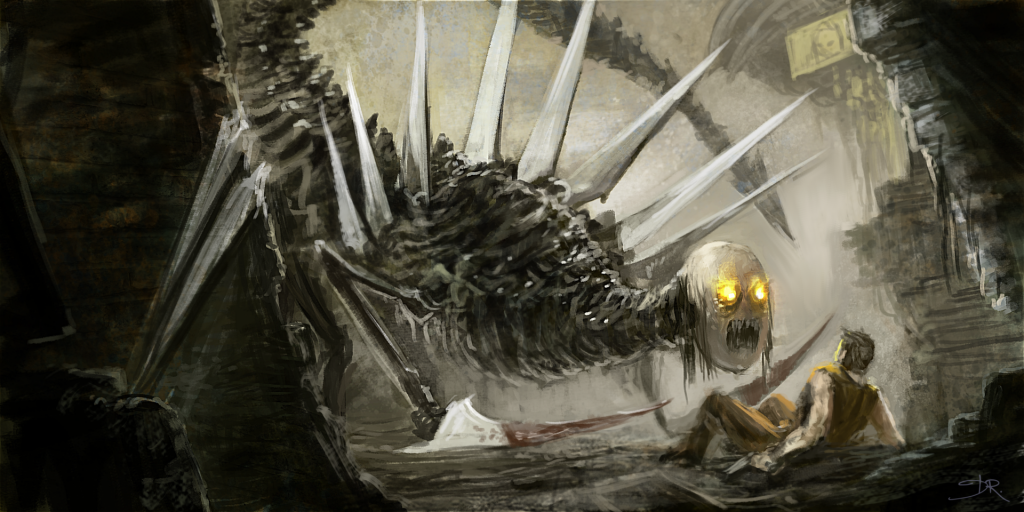
Golomancy —- Constructs
Antisemetic trappings aside, I think the inclusion of rules specifically adjudicating the construction and maintenance of magical constructs is very cool. It’s a little amorphous in terms of traditional game mechanics (speed, strength, health, etc) and focus instead on Old Norse runes that have keywords. It leaves me a bit disappointed, because there’s SO MUCH room here to build mechanically and universally interesting and invested systems for controlling and manipulating constructs, but I get the feeling this section isn’t fully formed and finished yet.
I’d suggest a LOT more time be spent on this section, it’s a very cool idea and an untapped market as far as I know for tabletop games. In fact, I’d go so far as to say there’s an ENTIRE GAME here that could be made around constructing, battling, repairing, and dueling constructed creatures: a perfect blend of Mecha fiction and Beast Tamer fiction. But that’s my entrepreneurial eye, I suppose.
Paladins, Resource Gathering (hunting, trapping, scavenging, mining)
You may be wondering: why group these up? These sections are usable, and wildly expansive, sporting hundreds and hundreds of options that are listed in relatively simple, straightforward terms.
I think that the huge mining section could be cut away and devoured by other portions of the book that would use the word count to greater effect, but the mining section is one of the most developed chapters in the book – which makes me think it wont be going anywhere. There’s not much to really say or pick apart here – most of these sections, nearly 14,000 words, are definitions and lists.
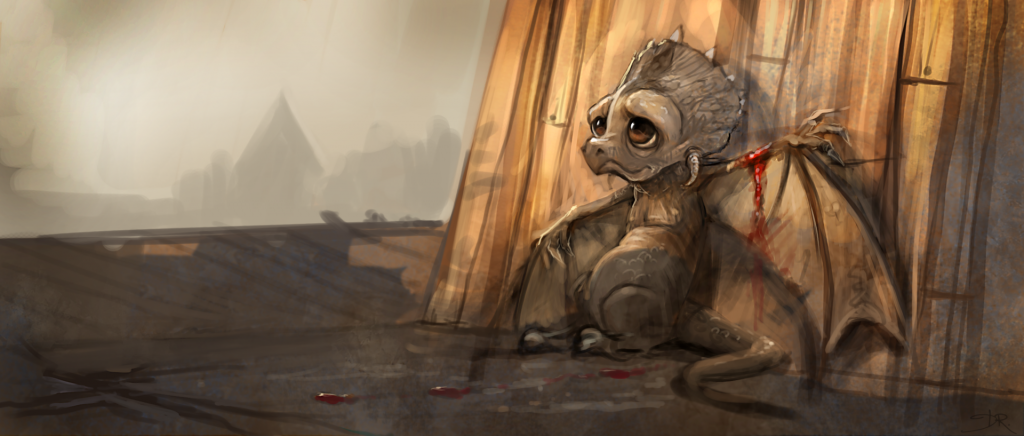
Overview
High Points:
- Structured well (you seldom have to go backwards or to different chapters for information). The main exception is not having the abbreviation definitions up-front. Having a splash page in the final version that puts the abbreviation definitions on the page opposite of “Creating a Character” solves that issue pretty much in its entirety when in combination with a character sheet.
- A peculiar and interesting central idea: the character is you manifested in this fantastical world. You have to determine some boosts and stats here or there, but overall, you are incentivized to roleplay as yourself, which makes for a unique fantasy experience.
- There’s uncountable combinations for characters and no real limiter. Much like Elder Scrolls videogames, your character can grow and change and do whatever you want, really, including shifting from specification to specification, melee to magic, etc. No two characters will ever turn out the same, I think.
- I think the technical writing style works very well for herbs, alchemy, and equipment. I can tell someone on this project has looked through their fair share of technical diagrams. Being able to, in a half page, list dozens of potion/supplement ingredients, their value, and what they can be brewed into works very well.
Pitfalls:
- Like most games in extended development, there’s a lack of primary focus to the CORE of the game. The biggest example for me is Skill Checks. You learn what they are on page 12, a d100 check – a d100 roll from “the environment.” But even then, it’s not plainly stated what makes a roll a success? A positive number? Is 0 a success? Are the two numbers just compared and the higher the outcome? Do skills level up as they’re used or through training? If it’s already there, it’s buried so deep that I didn’t’ see it.
- There are expansive systems in the game that feel more fleshed out than a core, target demographic might need. The Chemistry, Artificer, and Mining sections particularly stand out as being overdeveloped for the vast majority of gaming groups. While its HILARIOUS to have Artificer damage be calculated through ohms and voltage, that’s not really what’s here – it’s more of a workbook overview of electronic verbiage: how to bridge a circuit, what a capacitor does. There’s largely no presence of the game inside all of those terms and definitions and no mechanics for creations other than what is already scientifically available to us in the real world.
- When handling combat it’s a series of types of attack and defense, ways to gain advantages in situations, numerical bonuses depending on those combinations. All details that work with the system and coming to a conclusion for the player in mind. But in all of the above listed sections (other than mining hazards, those are great) there’s not much mention of the game or how those parts and ingredients can come together to serve the player. It’s thousands of words spent that could be better used elsewhere and shoring up much more interesting and game-centered sections.
Final Thoughts
Conjured Outcast is not a fully released game, but many reviews of it and overviews of its systems float around online. It’s situated squarely between fantasy and reality and blends the two together in a way that’s pretty interesting.
If Dungeons and Dragons were Minecraft, this would be the Terrafirmacraft mod: it wants to expand on the hand-waved details in as many ways as possible. Sometimes that focus can be frustrating (like having to find the perfect blend of copper and bismuth to make bronze based on the yield of each element) but there IS fun to be had in exploring those spaces in Tabletop Games.
With an interesting magic system and a weighty combat framework, Conjured Outcast seems focused, primarily, on tales of overcoming threats. The rest of the game is built around supporting central ideas that are commonplace to our real world as told in the fantastical. Even systems I’m not sure deserve the attention (such as mining) HAVE a place if we were plucked from the world and tossed into the fantastical (a bit of red quartz to power a machine to get home, for instance).
Six years in production, it’s easy to see that Conjured Outcast suffers from a bit of bloat around the edges – where ideas were piled together and stitched in before other, more weighty ideas were put atop them. But that’s not inherently a bad thing. There are a lot of interesting, inspiring ideas trapped in this system that I would love to see fully formed and presented when the game finally launches.

